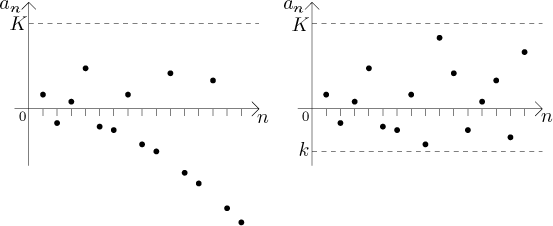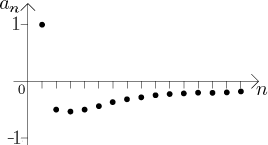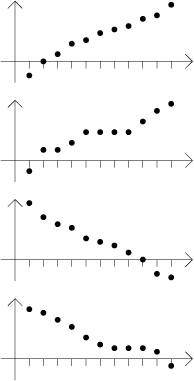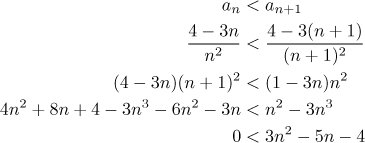
Below we look at boundedness and monotonicity, the basic two properties of sequences. We will introduce the necessary definitions, explain them and show a few examples. Many simple examples can be found in the next section: Important examples, and two solved examples can be found in Solved Problems.
A sequence is bounded if we can restrict the size of all its terms.
Definition.
We say that a sequence{an} is bounded from below if there is a number k (lower bound) such that for all n we havean ≥ k.
We say that a sequence{an} is bounded from above if there is a number K (upper bound) such that for all n we havean ≤ K.
We say that a sequence{an} is bounded if it is both bounded from below and from above.
So a sequence
Note that the words "for all n" mean "for all n that are used
for indexing the sequence"; typically it would be for all
When we look at a graph of a sequence, boundedness from below means that we
can draw a horizontal line so that all points representing the sequence stay
above this line. Similarly, boundedness from above is true if all points of
the sequence are below a certain line; boundedness means that the sequence
can be "closed" between two horizontal lines.
In the picture below, the left sequence is bounded from above, but not
bounded from below and therefore also not bounded. Actually, in the picture
we could put a horizontal line below all the dots, but we remember that the
picture shows only the beginning of the sequence, it is supposed to extend to
the right to infinity preserving the suggested tendencies, and there seem to
be dots going down at a regular rate; therefore, no matter where we put a
horizontal line, the dots will sooner or later drop below it.
The sequence on the right is bounded, bounded from above and bounded from
below.

Example: Consider the sequence
We look at the first several terms; the sequence begins

From the picture it would seem that

In the last line, the left inequality is true for all
Note:
Clearly once we have some upper or lower bound, we can also find many others.
In our example we used bounds −1 and 1, but we could have used for instance
If we suspect that a given sequence is bounded, we may save some time by
investigating its absolute value. For instance, in the above example we could
have proved that
This is in fact a general statement.
Fact.
A sequence{an} is bounded exactly if there is a number h so that|an| ≤ h for all n.
Proof: If this sequence satisfies the given condition, then
obviously
On the other hand, if we have a bounded sequence, then we have an upper
bound and a lower bound from the definition of boundedness, that is, there
are k and K so that
Note that boundedness is decided at "the end" of the sequence. A finite set
of numbers always has its maximum and minimum, so the boundedness can be
possibly violated only if we take into consideration an infinite number of
terms. To put it another way, disregarding a finite number of terms of a
sequence (its beginning for instance) does not change its boundedness
properties. Therefore, when we investigate boundedness, we do not really care
where did the indexing start; if it helps, we can disregard several first
terms and only consider
The following two statements should seem natural: If a sequence is bounded, then all its subsequences are bounded. If a sequence has an unbounded subsequence, then the sequence itself is also unbounded.
Here we define what it means that a sequence is monotone. This is a general notion encompassing the notions increasing and decreasing.
Definition.
We say that a sequence{an} is increasing if for all n we havean < an+1.
We say that a sequence{an} is non-decreasing if for all n we havean ≤ an+1.
We say that a sequence{an} is decreasing if for all n we havean > an+1.
We say that a sequence{an} is non-increasing if for all n we havean ≥ an+1.
We say that a sequence{an} is monotone if it is any of the above.
For proper understanding of the definitions we have to realize the
following. Given n, then an represents a
certain term of the given sequence and
Thus in the increasing sequence, each successive term must be larger than the
previous one, throughout the sequence; a non-decreasing sequence is required
to also keep going up, but it can also sometimes (or always) stay the same -
the only thing forbidden is to go down somewhere. This should all become
clear once you look at the four typical examples below. They are in the same
order as the notions in the above definitions.

Note that there are various relationships between these notions. An increasing sequence is automatically non-decreasing, while a decreasing sequence is automatically non-increasing. There are even sequences that are both non-increasing and non-decreasing - namely all constant sequences. On the other hand, an increasing sequence can not be decreasing and vice versa.
Example:
Consider the above example

What can we say about monotonicity of this sequence?
Since the second term is smaller than the first one,
Note that if we disregard the first two terms and consider the sequence

The last inequality is true for all
Note how we substituted for
We see that unlike the boundedness, monotonicity can be changed by adding/removing some terms to/from a sequence.
However, in one direction we have a positive statement: If a sequence is monotone, then all its subsequences are monotone. A few pictures should convince you that this statement might be true. Note that also the "direction" is preserved, a subsequence of a sequence going "up" will still go "up". However, sometimes the exact type changes.
Example: Consider the sequence defined for
![]()
Than is, if n is even, then
If we start with a sequence that is not monotone and take a subsequence, then
the situation can stay the same, or it can also improve. For instance, if we
take every second term from the alternating sequence
Monotonicity sometimes helps when exploring convergence, see Basic properties in Theory - Limit.
Important note.
Unfortunately, the terminology above is not generally accepted. It is favored
by many authors, but many authors also favor a competing terminology. Instead
of the notions (in the above order)
increasing, non-decreasing, decreasing,
non-increasing
they use
strictly increasing, increasing, strictly decreasing,
decreasing.
They use monotonicity as above, but for the first and third notion they also
use the common name strict monotonicity.
This confusion is unfortunate, but fortunately it does not lead into a big
trouble. In theorems we usually require that a sequence is monotone, at the
definition of which both schools agree. All in all, as usual, the prof giving
the course you are attending is always right, so check which terminology
he/she uses and stick to it. Here we will stick to the one defined above, in
particular because my prof used it and so I am passing it on.
However, the reader should be warned that there is a place where the two
schools collide: when it comes to theorems relating derivative to
monotonicity; therefore when reading about that, one should check what
terminology is used.